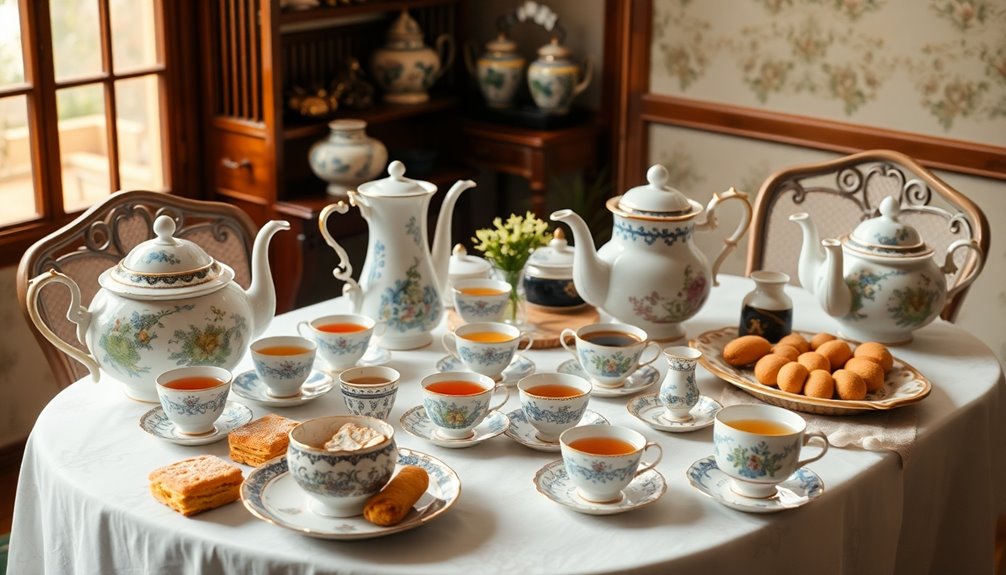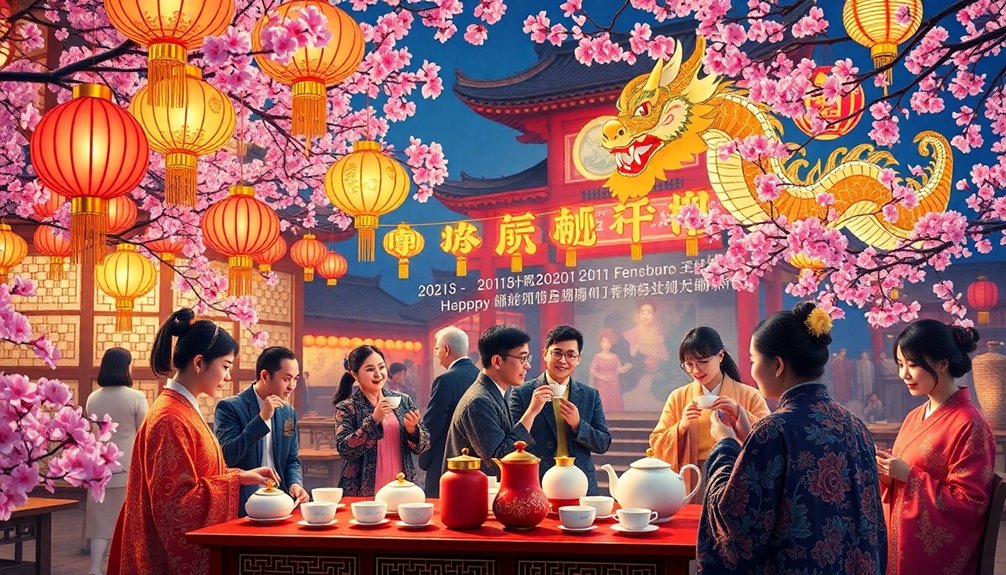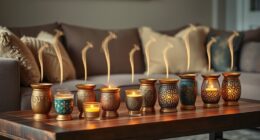To master the Gongfu Tea Ceremony, focus on precision and mindfulness. Use a small teapot or gaiwan, maintaining a high leaf-to-water ratio for intensified flavor. Each tea type requires specific temperatures: green tea at 160-180°F, oolong at 190-200°F, and black tea at 200-212°F. Perform multiple short infusions, typically lasting 5-30 seconds, to unveil the tea's evolving profiles. Cultivate a communal atmosphere with careful preparation and sensory appreciation. Respect the cultural roots of this ancient practice. There's much more to uncover about enhancing your practice and deepening your understanding of this beautiful tradition.
Key Takeaways
- Familiarize yourself with the specific water temperatures for different tea types to achieve optimal brewing results.
- Use a high leaf-to-water ratio to intensify flavor and enhance the tasting experience.
- Practice short infusions to minimize bitterness and reveal the tea's aromatic qualities.
- Pay attention to the details of preparation and presentation to honor the cultural significance of the ceremony.
- Engage in mindful appreciation of the tea's aesthetics, aroma, and taste while fostering a communal atmosphere.
Introduction
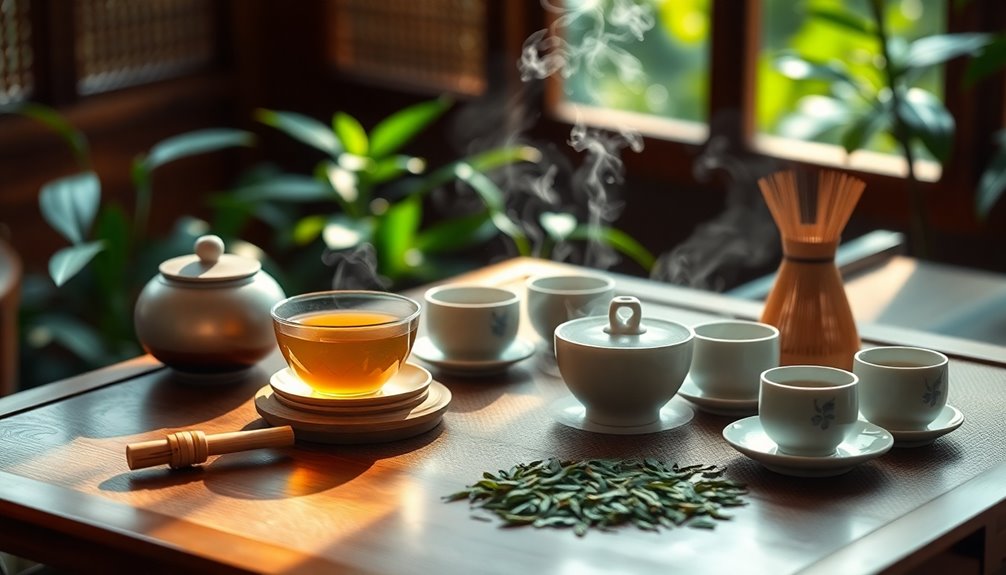
Gongfu tea ceremony isn't just about brewing tea; it's an art form that celebrates the intricate process of making a perfect cup. In this ceremony, you'll use a small teapot or gaiwan, allowing for focused brewing that enhances the tea's taste. The key lies in precision—pay attention to the leaf-to-water ratio, ensuring you extract the best flavors from your leaves.
During the ceremony, you'll engage in multiple infusions, typically 5-7 brews, revealing the evolving profiles of the tea with each steep. This method highlights the unique aroma and flavor characteristics, making each sip an experience to savor.
Water quality plays a significant role too; different teas require specific temperatures—green tea at 160-180°F, oolong at 190-200°F, and black tea at 200-212°F—to unlock their full potential.
As you participate in the Gongfu tea ceremony, take a moment to appreciate the aesthetics and sensations. Engage your senses in the aroma and taste, and share your reflections with others. This mindful practice fosters a deeper connection not only to the tea but also to those around you, enhancing the communal aspect of this beautiful tradition.
Cultural Significance of Gongfu Tea

The cultural significance of Gongfu tea extends far beyond its brewing techniques; it's a celebration of Chinese heritage and communal connection. Known as Gongfu Cha, this tea preparation method reflects a rich cultural heritage that spans over 3,000 years. It embodies hospitality and respect, allowing you to engage deeply with the traditions that promote mindfulness and appreciation of nature.
Traditionally associated with oolong tea, pu erh, and black tea, Gongfu tea emphasizes meticulous attention to detail through short infusions that enhance the overall experience. Each step in the process invites you to savor the nuances of flavor and aroma, transforming a simple cup of tea into an art form. This practice is rooted in Chinese history, with its techniques blossoming in regions like Chaozhou and Fujian, now celebrated worldwide.
Engaging in Gongfu tea rituals fosters social connections and shared experiences, making each session an opportunity to bond with others. By immersing yourself in these rituals, you not only enjoy a delicious brew but also participate in a meaningful exchange that honors your cultural heritage and deepens your understanding of the world around you.
Brewing Techniques Enhance Flavor
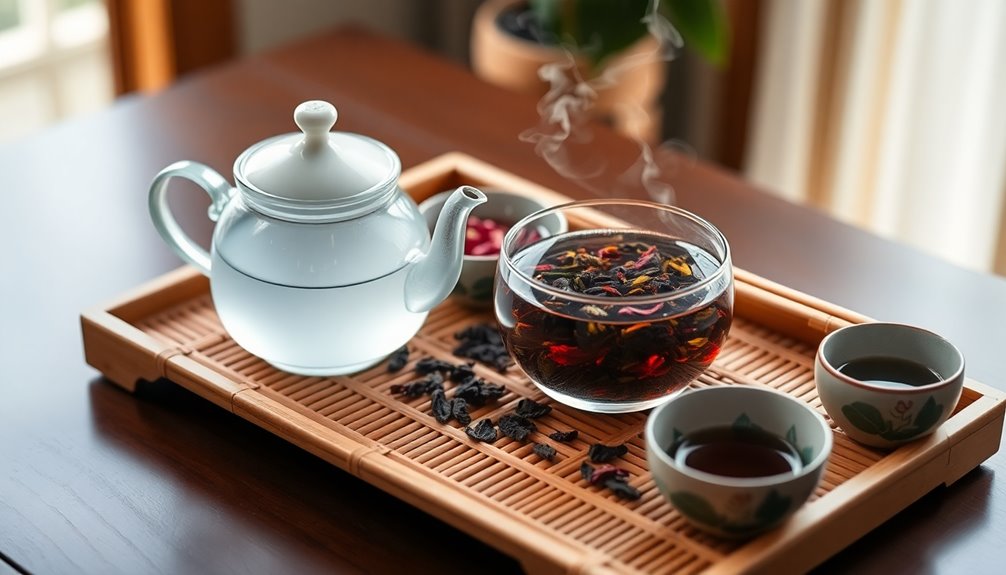
Mastering the brewing techniques in a Gongfu tea ceremony can significantly enhance your tea experience. By using a high leaf-to-water ratio, typically around 1 gram of tea per 15 ml of water, you intensify the flavor profile, allowing for a richer tasting experience.
The Gongfu tea method emphasizes multiple infusions, usually lasting between 5 to 30 seconds. This approach helps extract the nuanced flavors and aroma of the tea leaves without introducing bitterness.
Different types of tea require specific water temperatures for optimal brewing. For instance, green tea should be brewed at 160-180°F, oolong tea at 190-200°F, and black tea at 200-212°F.
Pouring the water from a height during the infusion process not only ensures even saturation of the leaves but also aerates the water, enhancing flavor extraction.
Experimenting with steeping times and adjusting the amount of tea allows you to explore the evolving flavor characteristics across multiple brews. With high-quality tea leaves, you can typically achieve 5-7 infusions, each revealing a different facet of the traditional Chinese tea experience.
Enjoy discovering the depth of flavors that Gongfu tea can offer!
Cultural Rituals in Tea Preparation
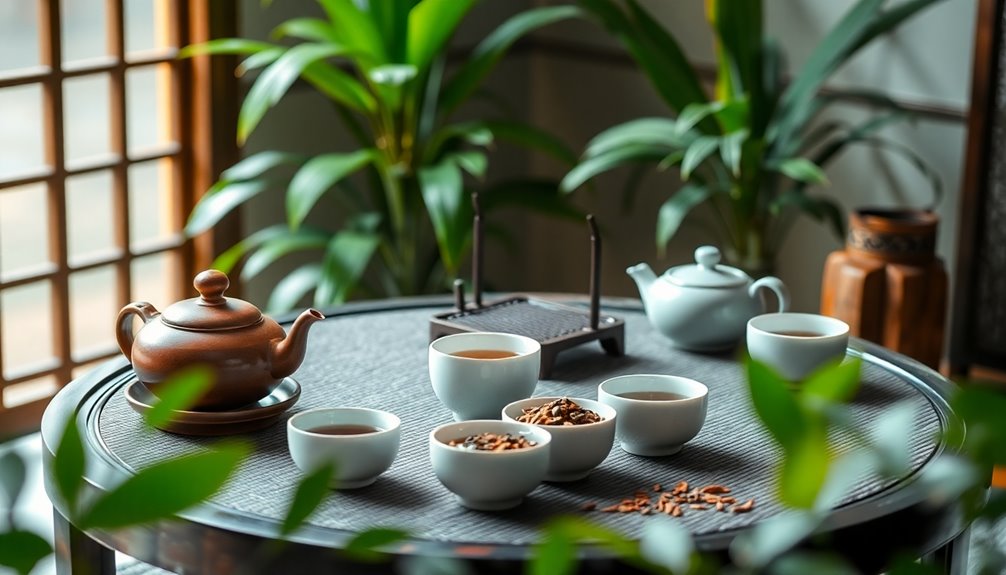
Building on the intricate brewing techniques that enhance flavor, the Gongfu tea ceremony also embodies rich cultural rituals that elevate the experience beyond mere drinking. This Chinese tea ceremony showcases meticulous attention to detail in both preparation and presentation, transforming tea leaves into a form of art steeped in cultural heritage.
Each step of the tea ritual, from rinsing teaware to pouring water, establishes a respectful tone that honors the tea's origins.
As you engage in this ceremony, the act of incense burning creates a calming atmosphere, enhancing mindfulness and promoting a deeper connection among participants. You'll find that guests are encouraged to appreciate the tea leaves visually and aromatically, fostering sensory appreciation that enriches the experience.
The Gongfu cha isn't just about sipping tea; it's about creating a communal atmosphere where everyone shares in the appreciation of the moment. Each carefully executed step invites connection, allowing you to bond with others over the shared experience of tea preparation.
Embrace these cultural rituals, and you'll find that the art of Gongfu tea elevates your understanding and enjoyment of this ancient tradition.
Cultural Appropriation Concerns

Engaging in the Gongfu tea ceremony can bring up important cultural appropriation concerns, especially when individuals from outside the Chinese culture participate without grasping its historical significance.
The art of Gongfu tea isn't just about brewing tea; it's a rich tradition steeped in mindfulness, community, and respect for its roots. When you approach Gongfu tea as merely a trendy experience, you risk diluting its cultural value and misrepresenting its authentic form.
To truly honor this practice, it's crucial that you educate yourself about the rituals, tools, and philosophies that underpin the ceremony. Understanding these elements helps prevent cultural insensitivity and promotes genuine appreciation for Chinese culture.
Critics highlight that failing to recognize Gongfu tea's origins can perpetuate stereotypes and overlook the importance of its traditions.
Practical Applications

Understanding the cultural significance of the Gongfu tea ceremony sets the stage for its practical application in your own tea brewing rituals. Start by creating a clean, distraction-free space for your Gongfu cha, gathering all necessary teaware, including a gaiwan, fairness pitcher, and small cups.
Choose high-quality loose leaf tea, using around 5-6 grams for every 120ml of water, and warm your brewing vessel with hot water. This enhances the flavor extraction and prepares the leaves for optimal infusion.
Pay attention to water temperature: steep green tea at 160-180°F (71-82°C) and oolong tea at 190-200°F (88-93°C). Short infusion times are essential—begin with 5-10 seconds for the first brews and gradually increase for subsequent steepings. This allows you to explore the evolving taste of the tea.
Engage your senses throughout the tea session by observing the color, aroma, and taste of each infusion. This mindfulness deepens your appreciation for the nuances in every cup, making each Gongfu cha experience unique and enriching.
Embrace the ritual, and let it transform your approach to tea brewing.
Conclusion
Mastering the gongfu tea ceremony is more than just brewing tea; it's about embracing a rich cultural tradition. By respecting its rituals and honing your techniques, you'll enhance not only the flavor but also the experience for yourself and others. Remember to approach this art form with mindfulness, appreciating its roots while being aware of cultural appropriation. Whether you're sharing it with friends or enjoying a quiet moment alone, the gongfu tea ceremony can deepen your connection to tea and culture.


